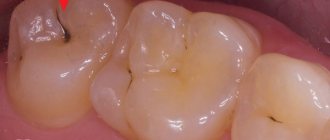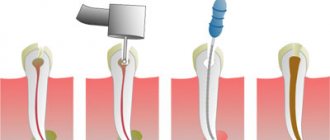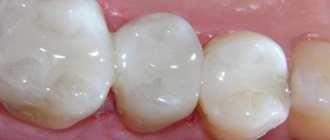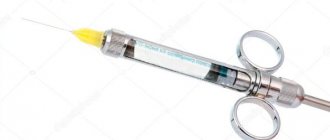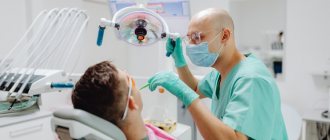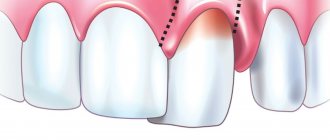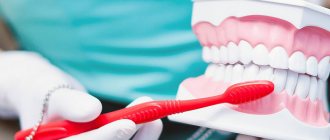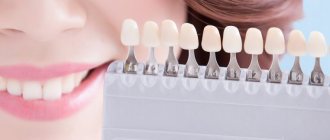Causes of caries
Most often, the appearance of caries is caused by inappropriate oral hygiene and an unbalanced diet - abuse of fatty, salty and too acidic foods, which leads to the destruction of the enamel layer. Among other provocateurs of carious lesions:
- deficiency of vitamins in the body (calcium, vitamin A, C, etc.);
- unfavorable environmental conditions (poor quality of drinking water);
- disturbances in the functioning of the gastrointestinal tract;
- genetic predisposition;
- disruption of the salivary glands;
- taking certain medications.
Concomitant serious diseases, for example, tuberculosis and other pathologies that undermine the immune system, also lead to the appearance of signs of caries.
Stages of caries development
Caries is usually classified according to location and severity. From the point of view of determining treatment tactics, the stage of disease development is of greatest importance. In dentistry, there are 4 stages of development of dental caries:
- Elementary. The enamel layer gradually changes color - white spots appear on the surface of the teeth. Otherwise, caries occurs without a trace for the patient.
- Surface. Dark spots are visualized on the enamel. A damaged tooth does not react for a long time to cold, hot, sour and sweet foods.
- Average. The development of the disease leads to damage to dentin. Pain in response to external irritants is more pronounced and prolonged.
- Deep. The disease is accompanied by extensive damage to enamel and dentin. The pain does not go away even after using analgesics.
The earlier the stage of development of caries, the greater the likelihood that the disease can be cured with few sacrifices.
Preparation for treatment with braces, veneers and aligners
| Preparing for treatment | ALINERS | BRACKETS | VENEERS |
| Virtual setup: a computer program allows you to create a three-dimensional model of the dental system | Yes | No | Yes |
| Opportunity to discuss the results and progress of treatment with the doctor | Yes | No | Yes |
| Patient participation in treatment | Yes | No | No |
When a patient sees on the computer his future smile, in which all the teeth are aligned, it seems fantastic. But in fact, the 3D virtual setup is a super program from Star Smile, considered one of the best in the world and used by clinics in more than 25 countries
world and
100 cities of Russia
. This program for visualizing the future result of treatment using more than 40 parameters simulates all processes of bite correction and allows you to accurately plan treatment. Exactly with the same great result that the patient will see BEFORE the start of treatment.
Braces do not have this option - all treatment is carried out blindly, and the patient can only live in hope for the future.
And a huge plus in preparing and conducting treatment is the participation of the patient. The aligners are removable and are completely under the control of the person being treated. Therefore, the answer to the question: “What is better - braces or aligners at the initial stage?” — aligners.
Caries in adults
Caries in adults develops quite slowly. Most patients seek help from a dentist at the stage of medium and deep caries. After a detailed diagnosis, the doctor most often resorts to the traditional method of treatment; in case of deep tissue damage against the background of complicated caries (pulpitis), endodontic therapy cannot be avoided.
Prosthetics on implants
This method is good because it can be used when one or more teeth are missing. In case of complete edentia, it is also used, but there is no talk about preparation. A metal pin is inserted into the place of the lost tooth, and dentures are put on it, without grinding the adjacent teeth.
What are the advantages:
- neighboring teeth are not affected and remain “alive”;
- the number of artificial teeth can be any;
- the method is used to restore anterior and chewing teeth;
- the implant prevents bone tissue atrophy;
- Implants come with a lifetime warranty.
For prosthetics on implants, you can use any of the following methods:
- Removable prosthetics
A removable denture is attached to part of the jaw or to the entire dentition much better than on natural teeth. Removable structures do not fall out arbitrarily, but the patient is able to remove them himself for hygiene procedures. Conditionally removable ones are secured with screws; only a dentist can remove them.
- Fixed prosthetics
The classic bridge design has proven its effectiveness. This is a reliable way to restore your teeth. When attached to implants, all the disadvantages disappear: dentures are without grinding, which means there is no need to depulpate the supporting teeth. The metal pin is stronger than the natural root, the design will last for many years. Implants prevent bone tissue from resorption. There are no restrictions in the choice of materials for crowns, and the number of artificial teeth can be more than 2
.
Unfortunately, sometimes there are contraindications to installing implants. In such cases, other prosthetic methods are used without turning adjacent teeth.
How are caries treated in dentistry?
At the initial stages of development of dental caries, the problem can be successfully solved using one of the modern non-invasive methods of therapy. The goal of this approach is to prevent progression of the disease and save the affected tooth. Progressive caries must be treated in the classical way.
Read more about the stages of invasive treatment and modern methods of getting rid of caries.
Stages of caries treatment
Otherwise, the classic method of caries removal is called surgical. The doctor removes the affected tissue (fragments of enamel and dentin) and then fills the resulting cavity until the anatomical shape of the unit is completely restored. The process includes several successive steps:
| Cleaning a tooth from plaque | To remove tartar, which will hinder a successful recovery, the dentist uses a surgical instrument, ultrasound. Air abrasive cleaning can remove plaque. |
| Determination of tooth color using a special scale | This stage is very important when treating teeth in the smile area. The doctor will have to give the patient a filling that will not differ in color from natural enamel. For these purposes, the dentist uses the standardized Vita scale. |
| Anesthesia | For the comfort of the patient and the doctor, an anesthetic is administered to the patient. Depending on the method of administration and duration of action, there are several types of anesthesia. Before using a specific pain reliever, a good dentist will make sure that the patient is not allergic to the active ingredient. |
| Drilling out carious tissues | At this stage, the doctor drills out damaged dental tissues - eliminates destroyed dentin and enamel edges hanging over the cavity. If the drilling technology is violated and some of the affected fragments are preserved under the installed filling, there is a high risk of developing secondary caries. |
| Isolation of tooth from saliva | This measure is necessary to ensure that moisture does not get under the filling, otherwise its survival rate will be low and the filling will soon fall out. A special rubber scarf with a hole for the teeth helps to properly isolate the work area. It's called a rubber dam. |
| Medical treatment of carious cavity | To isolate the tooth from saliva, the doctor treats the dental cavity with antiseptic drugs to destroy all bacteria and prevent inflammation under the filling. |
| Restoring the contact point between teeth | The contact point is the place where adjacent teeth come into contact. It is important to restore it to prevent damage to the interdental space, accumulation of food between the elements and the development of caries. At this stage, the dentist uses tools to restore the point of contact: matrices, wedges, metal rings, cones, attachments, etc. |
| Etching enamel with acid | In order for the adhesive, which the doctor will apply at the next stage, to penetrate deep into the dental tissue, the enamel must be etched with a special gel. The product contains an acid based on phosphorus. After etching the surface, the dentist washes off the gel and dries the work area. |
| Treatment of dentin and enamel with adhesive | Cleaned dentin and enamel are covered with a layer of adhesive - a composition that promotes better adhesion of the filling to the walls of the tooth. |
| Applying a gasket under the filling | The doctor installs a gasket at the bottom of the cavity, which acts as an insulator for the future filling from the tooth surface. |
| Sealing | At this stage of therapy, the dentist uses a photopolymer composite material from which he forms a filling. The material must be applied in layers to ensure high-quality fixation. Each layer is followed by illumination of the composition with a special lamp. The technology allows the doctor to determine the location of the polymer and dry the material well. |
| Grinding and polishing of teeth | The caries treatment process cannot be completed without grinding and polishing: the primary photopolymer filling has a rough surface and stands out against the background of natural enamel. The doctor completes the therapy using a drill and special attachments. Afterwards, all that remains is to cover the surface of the tooth with a special composition that will allow the enamel to quickly recover. |
Modern methods of caries treatment
It is not necessary to remove the affected dental tissue and fill the cavity in all cases. If a patient consults a doctor with initial symptoms of caries, the problem can be solved using one of the gentlest methods. These methods are used to treat caries in adults and children.
Remineralization
Modern methods are applicable when detecting initial caries. The doctor treats the surface of the damaged unit with a special composition that contains fluorine, calcium and phosphorus.
Infiltration method using ICON technology
Chemical-mechanical method of treating caries. The therapeutic measure is applied only at the primary stage of the disease, when spots appear on a smooth surface or between units. The dentist covers the local area of the tooth with a gel, which breaks down the injured enamel layer. Then the inflammatory focus is dried using ethyl and air flow. To fill the pores of damaged enamel, the doctor coats the area with a polymer resin. Treatment of caries in this way lasts no more than 15 minutes.
Ozone therapy
The principle of the therapeutic technique is simple - ozone, as a natural antibacterial agent and oxidizing agent, destroys bacteria, the activity of which leads to the development of caries. In addition to the antibacterial effect, ozone therapy also demonstrates a restorative effect (strengthens the enamel layer).
When using ozone therapy for caries, the doctor uses a special device that converts oxygen into ozone and delivers it to the local area. Once the ozone kills the bacteria, it turns back into oxygen.
A gentle method of therapy allows you not to injure healthy cells, affecting only damaged ones. Another advantage of the approach is that there is no need to administer an anesthetic. The procedure lasts about a minute and is successfully used in the treatment of caries at the white spot stage and as a preventive measure for the disease.
Air abrasive method
In this case, caries is treated without a drill, but using an alternative device that delivers a powerful stream of abrasive elements. The technique allows you to literally “knock out” superficial caries with an abrasive. The air-abrasive flow affects only softened (damaged) dental tissues; anesthesia is not required.
Gentle therapy “insures” against the formation of microcracks in the enamel after classical treatment. In the case of superficial caries, the technique is not applicable in all clinical cases.
Laser therapy
This method of therapy is recognized as effective for superficial and even moderate caries. In practice, the technique is recommended for pregnant women and children. The procedure is painless due to the use of a bactericidal solution that cools the tooth. The equipment itself does not create vibrations that could increase pain.
The laser beam acts on the damaged area, evaporating the affected tissue, and additionally disinfects the formed cavity, while reducing the risk of relapse of the disease.
ART technique
Step-by-step treatment of caries, during which the dentist, using a professional instrument, cleans the affected tissue and fills the formed cavity with dental cement. This method of therapy appeared in third world countries, and is sometimes used in developed countries. Manual work ensures precision and allows you to preserve healthy dental tissue to the maximum extent.
Dental restoration methods
The direct method is the application of a light-curing composite material. The doctor forms a layer, illuminates it with a UV lamp, and so on until he completely restores the shape of the tooth. A rich palette allows you to choose the shade of the composite to match the natural tone of your teeth. Finally, sanding is carried out. The restoration will last up to 5-7 years.
The indirect method is the use of veneers or crowns for chewing teeth. They are made in a dental laboratory from ceramic masses and metal or zirconium frames. Service life – 10-15 years.
Modern dentistry – does it hurt?
Today it is logical to position the patient’s comfort on the same level as the results of therapy. Proper use of anesthesia in a dental clinic allows you to achieve the best results even in the most difficult cases.
Today's best method of pain relief in dentistry is the introduction of formulations based on articaine, a component that has minimal effects on the human vascular system and has a long-lasting effect.
In practice, there are several techniques for pain relief:
- applique. The doctor does not use a syringe or needle; the drug is applied to the mucous membrane in the form of a spray or using a gel-soaked tampon. This method of pain relief is used for relatively painless manipulations, for example, when giving injections to children;
- infiltration The doctor injects an anesthetic into the upper part of the tooth root. This anesthesia allows a person to be relieved of pain when treating deep caries of one tooth. The only condition for ensuring maximum effectiveness of the procedure is the introduction of the drug into the root of the upper tooth (due to the anatomical features of the jaw structure);
- conductor. The doctor injects the drug into the nerve or near the nerve trunk. The patient loses sensitivity in the local area for 2-3 hours;
- intraligamentary. Otherwise, the technique is called intraligamentous. The dentist injects an anesthetic with a special thin needle into the periodontium itself. This anesthesia allows you to “freeze” half of the jaw and lasts about 40 minutes. The method is most common in pediatric dentistry.
Manufacturing and installation of bite correction systems
| Manufacturing and installation | ALINERS | BRACKETS | VENEERS |
| Preparation time | 7 days | 1-2 days standard | from 7 days to 30 |
| Installation time | from 45 minutes to 1 hour both jaws | 3-6 hours | each jaw 6-8 hours |
| The need to take impressions before installation | intra-oral scanning + impressions (optional) | Yes | Yes |
| The need to use anesthesia | No | No | Yes |
Any production of bite correction systems implies the patient’s obligation to make impressions
. Of course, with the help of a doctor. The procedure itself is inconvenient, but it must be done. Aligners are preferred here, since aligners are already digital, computer technologies, and intraoral scanners can be used in their work: the doctor ran such a scanner over the patient’s teeth, and the computer showed their appearance. All of your both jaws on the computer screen are as if they were alive. There is no need to take dental impressions. But, it’s true, not many clinics yet have such advanced technologies. Therefore, the advantage of aligners here is not particularly strong. Therefore, let's also compare the manufacturing and installation times of bite correction systems.
The fastest braces to make. The slowest ones are veneers.
Veneers or braces
? Standard braces are made for you within 1-2 days. The longest in production are veneers. This is understandable. In fact, each dental plate is sharpened for each of your teeth. Therefore, veneers can take up to 30 days. Aligners confidently hold second place - the standard production time is up to 7 days maximum.
The fastest to install are aligners.
Over time of installation
Braces take longer to install than aligners; it can take you up to 6 hours. Aligners are the easiest and fastest way: installation on both jaws will take a maximum of 1 hour. But with veneers you will have to suffer - since each jaw is glued from 6 to 8 hours.
Cost of treatment with aligners
Now you have the opportunity to get a beautiful smile at a cost:
- for the simplest case of correction with aligners from 4,000 rubles
per month - in the most difficult case of teeth straightening with aligners - less than 10,000 rubles
per month
In reality, Star Smile today has the lowest prices
in Russia for aligners compared to all aligner manufacturers! (Invisalign, Orthosnap, 3D Smile)
Find out all prices for aligners
Cost of treatment with aligners:
Star Smile also has the best prices for treatment with aligners in Russia, which covers more than 100 cities of the Russian Federation, since the company’s main goal is to make prices for aligners affordable for the vast majority of patients. You can see this for yourself - look at the prices for aligners.
Is it possible to cure tooth decay at home?
Treatment of caries at home is advisable only at the initial stage of the disease. However, only a dentist can correctly determine the stage of the disease.
Remineralizing pastes and gels with calcium and fluoride can be used as effective treatments for caries at the spot stage. Regular use of these products will prevent further development of caries and reduce tooth sensitivity to external irritants.
You should not choose a paste or gel on your own. This should be done by the attending physician, who will make a choice in favor of a particular remedy, based on the approximate percentage of fluoride and calcium in the person’s diet. Most often, dentists advise alternating pastes containing calcium and fluoride.
In case of severe tooth sensitivity, the paste can be used not only for its intended purpose, but also for applications.
Medium, deep caries cannot be cured at home - the disease will gradually progress even if the factors provoking the disease are reduced.
Prevention
To avoid the development of caries and its complications, experts advise following a few simple rules for preventing the disease:
- brush your teeth twice a day, use dental floss and mouthwash regularly;
- eat right - include foods rich in vitamins, calcium and phosphorus in your diet;
- give up bad habits - smoking, alcohol abuse;
- monitor the general condition of the body - periodically undergo tests at the clinic, undergo preventive examinations at least twice a year at the dentist.
In order not to lead to the development of complications of caries (pulpitis), in which it is necessary to remove the tooth pulp, fill the canals and restore most of the unit, pay attention to any unpleasant symptoms from the oral cavity. If you notice signs of tooth decay, contact your dentist immediately.
Author: Elena Kopylova Dentist-endodontist. Work experience more than 12 years.
The information is for reference only. Before treatment, consultation with a doctor is necessary.

